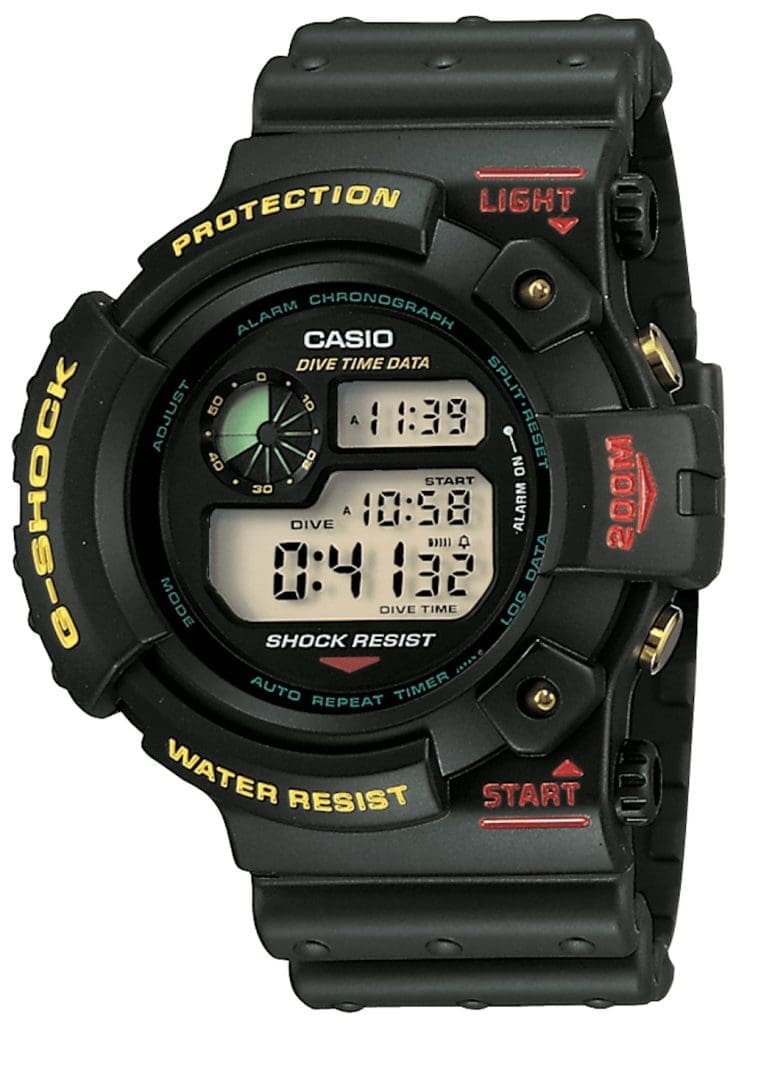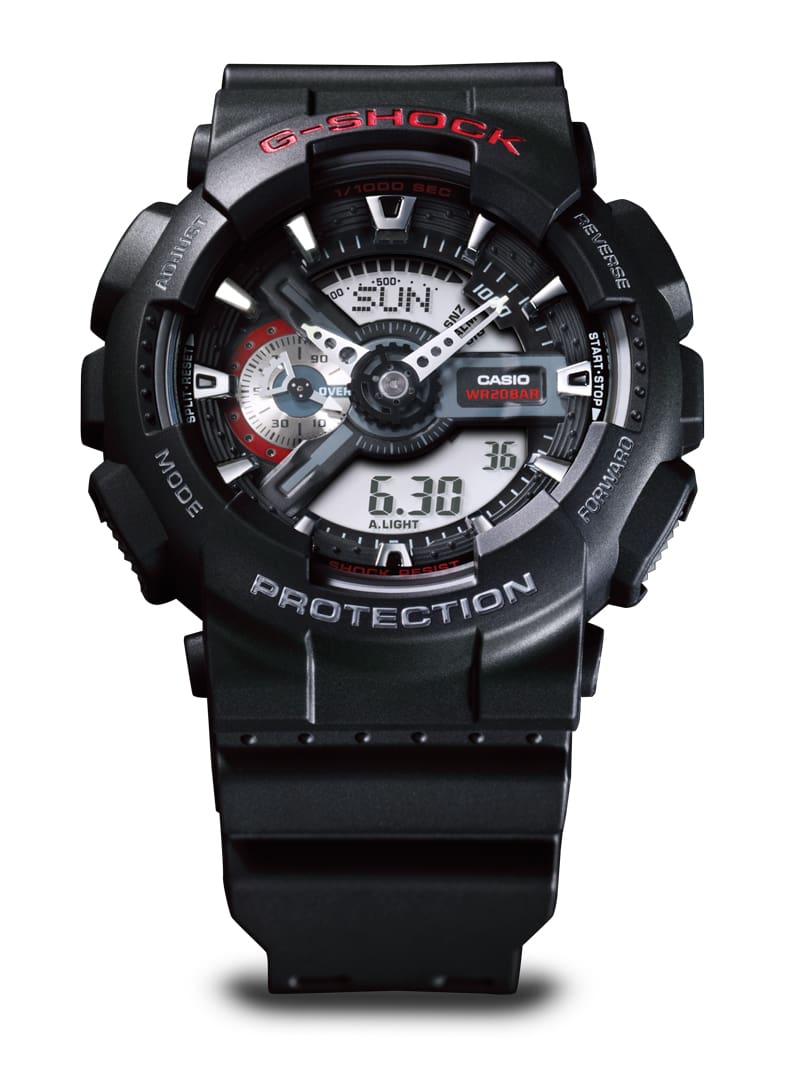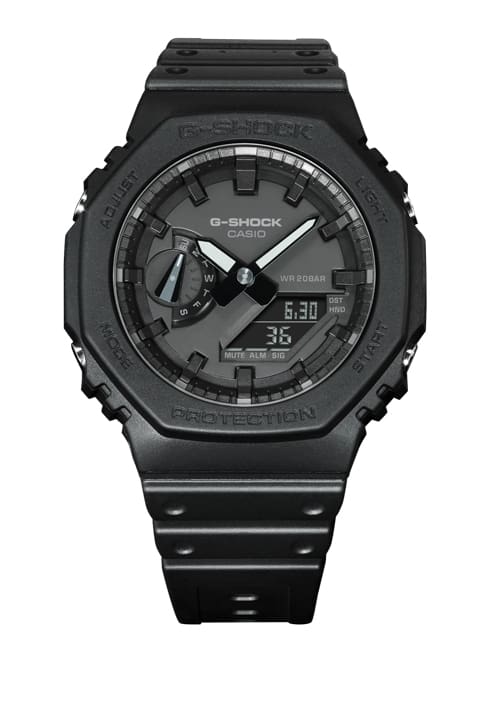The Unstoppable Evolution Of G-Shock
Since its inception in 1983, the Casio G-Shock watch has chiseled out a reputation as the toughest watch on the planet. However, its significance extends far beyond its durability. G-Shock has become a revered timepiece, god-tier as some would suggest – collected by a diverse range of individuals, from Navy SEALs to skaters to tech Billionaires and even the odd magazine editor along the way.
The Birth of Toughness
(1983-1990)
In 1981, engineer Kikuo Ibe, the head of watch design at Casio, embarked on a mission to create a watch that would never break. The inspiration came to him when he accidentally dropped and shattered a mechanical watch that his dad had passed down to him. And while he might have destroyed a family heirloom, this moment was the beginning of a legacy that has spawned millions of timepieces. Determined to develop a timepiece that could withstand the rigors of daily life, Ibe formed “Team Tough” with three members and established three key design criteria: withstand a 10-metre drop, withstand 10 atmospheres of water pressure, and have a battery life of 10 years. After overcoming numerous challenges and going through hundreds of iterations, the first G-Shock, the DW-5000C, was released in 1983.
The DW-5000C’s design has left an iconic silhouette on G-Shock DNA. Featuring a square-shaped case made of resin, a lightweight yet robust material, it encased the digital display with a chunky raised protective bezel, providing additional impact resistance. The buttons on the watch were oversized and positioned to be easily operated, even while wearing gloves.
Of course, one of the standout features of the DW-5000C was its ability to withstand shocks. The watch’s construction incorporated a unique shock-resistant system, inspired by the concept of a bouncing rubber ball. The internal components were protected by cushioning material, allowing the watch to withstand significant impacts without compromising its functionality.
The DW-5000C also introduced water resistance as a key feature of the G-Shock line. With its 10-bar water resistance rating, the watch was suitable for water sports and daily activities involving water exposure. This feature set the stage for G-Shock’s expansion into diver’s watches and further reinforced its reputation for toughness.
Even after several decades, the DW-5000C’s design remains iconic. Its square-shaped case, large buttons, and distinctive digital display have become synonymous with the G-Shock brand.
G-Shock doubled down on the toughness stakes with the Master of G series, launched in 1985, which was designed to meet the needs of those operating in extreme environments. Consisting of three sub-collections – the Mudmaster, Gulfmaster, and Gravitymaster – the Master of G watches incorporated specialized functions such as mud resistance, water depth measurement, compasses, altimeters, and more.
By the late 1980s, the G-Shock collection had expanded to an impressive lineup of 200 different models, each catering to various preferences and needs. Among the iconic models of that era, the DW-5600C-1V stands out as one of the most famous and revered. Released in June 1987, this watch echoed the shape of the original DW-5000C but came in blacked-out steel and with a higher water resistance rating. It was also the watch of choice for Keanu Reeves in the 1994 blockbuster movie Speed.

In the film, Keanu Reeves played the role of a brave cop who found himself caught in a high-stakes situation involving a bomb-rigged bus that couldn’t drop below a certain speed. As an integral part of his character’s attire, the G-Shock DW-5600C-1V became the perfect action hero’s watch. Adding to the watch’s allure, it is widely believed that the DW-5600C-1V worn by Keanu Reeves in the movie was actually his personal timepiece.
Beyond its association with Hollywood, the DW-5600C-1V earned another notable reputation. It became known as the “NASA” model because it was flight-qualified by NASA for space travel. Astronauts themselves have worn this particular G-Shock model during their missions, highlighting its durability and reliability in even the most extreme environments.
Technological Prowess Unleashed (1991-2000)
As the ’90s dawned, G-Shock continued to push the boundaries of watch engineering, unveiling a parade of technological marvels. The DW-6100, released in 1992, holds a special place in the hearts of watch enthusiasts and collectors alike. What set this model apart from its predecessors was its introduction of a built-in thermometer sensor, making it the first-ever sensor G-Shock. This innovation allowed wearers to monitor the temperature in both Celsius and Fahrenheit, catering to the needs of outdoor adventurers and professionals in various fields. I guess if you are freezing to death in some far-flung tundra, it is nice to know just how much by.
Alongside the thermometer, the DW-6100 also included a sunset sunrise indicator, and a handy micro LED light for in between sunset and sunrise. Throughout its production run, the DW-6100 saw several variations and limited editions, each adding its unique touch to the model.
In 1993 the DW-6300 was launched and became the granddaddy of the iconic Frogman line. It featured an asymmetrical design that would become synonymous with the Frogman series and was the first G-Shock model to achieve a genuine water resistance of 200 metres, meeting the rigorous standards of the international diving certification ISO 6425.
A year later the DW-6600 was launched and became the quintessential Navy SEAL watch within the G-Shock collection. The watch’s robust construction, shock resistance, and 200-metre water resistance made it well-suited for the demanding missions and rigorous training undertaken by these elite forces. The DW-6600 model also marked the transition to Electroluminescent backlight technology for G-Shock watches from backlights employing incandescent bulbs in earlier models. This combined with its reliability in extreme conditions, combined with its lightweight design and 24-hour mode made this the go-to watch for all aspiring Navy SEALs.
Building on the success of the DW-6300, Casio unveiled the second generation Frogman, the DW-8200, in 1995. This iteration introduced a titanium bezel to the G-Shock structure, combining strength and style. This cool use of metals combined with other tough materials would become more and more of a theme for G-Shock over the years.
In 1996, G-Shock unveiled the MR-G series, marking the brand’s foray into the realm of luxury watches. The MR-G watches featured high-end materials like titanium, sapphire crystal, and premium finishes. Despite their luxe aesthetics, the MR-G models didn’t compromise on the toughness side of course and maintained G-Shock’s renowned durability and resistance to impact and water.
Meanwhile, the popularity of the Frogman range continued to soar, attracting professional divers and collectors alike. And G-Shock answered with the Frogman MRG-1100 which made waves in 1999 as an all-titanium marvel, further solidifying its status as a sought-after timepiece.
Continuing with the water theme, the G-LIDE series, introduced in 1999, was just the ticket for surfers and boaties. These watches featured tide graphs, moon phase displays, and countdown timers specifically tailored for aquatic activities. Speaking from experience, these timers were great for working out just how much you had screwed up by when you wiped out on the first wave of a set.
Blending strength with elegance, the MT-G series debuted in 1999, showcasing G-Shock’s expertise in metal craftsmanship. These watches incorporated a combination of stainless steel and resin, providing exceptional durability while exuding a sophisticated aesthetic. The MT-G models featured advanced functionalities like GPS timekeeping, GPS hybrid radio-controlled technology, and Dual Core Guard Structure, offering the perfect balance between toughness and refinement.
Material Reinvention and Design Innovation (2001-2010)
As the world entered the new millennium and people realised that the Y2k bug wasn’t going to send us into a dystopian wasteland, G-Shock decided to go all out and release a groundbreaking timepiece that redefined the meaning of setting the correct time. The launch of the GW-100 in 2000, marked the advent of some very cool radio-controlled technology in G-Shock watches, enabling precise and accurate timekeeping by receiving calibration signals from multiple global locations. By utilising calibration signals transmitted from one of six worldwide locations, including the United States, United Kingdom, Germany, China, and Japan, the watch automatically adjusted its time and ensured unparalleled accuracy.
Following its groundbreaking release, the GW-100 served as a foundation for subsequent G-Shock models. Over the years, Casio continued to refine and enhance the watch’s features including additional functionalities, such as altimeter, compass, and moon phase displays.
In 2001, the GW-200 Frogman with Tough Solar technology was introduced, revolutionizing the power source of the timepiece. The GW-200 series also expanded the Frogman’s color palette.
And speaking of fashionable, in 2003, the G-5600 series strutted onto the scene, combining rugged durability with sleek aesthetics. It was a design fusion that appealed to urban trendsetters, bridging the gap between utilitarian and fashionable.
In 2009, the GWF-1000 marked another milestone for the Frogman line, featuring Multi-Band 6 radio synchronization and a comprehensive suite of diving functions, including a dive time measurement mode and a tide and moon phase graph.
A Fusion of Fashion and Functionality (2011-2020)
As G-Shock entered the second decade of the 21st century, it embraced its dual identity as a symbol of both toughness and style. In 2011, the GA-110 series roared into the spotlight, featuring oversized cases and vibrant color combinations. It was a bold statement, capturing the essence of street fashion.
In 2012 as the Walking Dead was becoming one of the world’s top TV shows, G-Shock released the GW-9400 Rangeman, a watch designed for outdoor adventurers and survivalists. This is probably an unrelated factor but I like to think that they are connected. The Rangeman offered an array of features, including a built-in triple sensor (altimeter, barometer, and compass), solar-powered functionality, and a carbon-fibre insert band for increased durability. With its robust construction and comprehensive set of tools, the Rangeman quickly became a favorite among outdoor enthusiasts and it was my first option in case of a Zombie apocalypse.
In 2013, G-Shock introduced Bluetooth connectivity to select models, the Bluetooth-enabled G-Shock watches allowed users to sync their timepieces with smartphones, providing automatic time adjustment, notification alerts, and even remote control of phone functions.
2014 marked the introduction of the GPW-1000 Gravitymaster, a timepiece that combined GPS and radio-controlled timekeeping technology. The GPW-1000 featured precise time synchronization through GPS signals and radio wave reception. The Gravitymaster also boasted enhanced shock resistance, solar-powered functionality, and an array of aviation-inspired features.
In 2018, G-Shock introduced the Carbon Core Guard structure, a significant design innovation that improved both strength and lightweight performance. This construction technique involved incorporating carbon fibre reinforcement into the watch’s resin case, resulting in increased durability while reducing overall weight.
This same year G-Shock went full metal jacket with the GMW-B5000, a model that combined the iconic square design of the first-generation G-SHOCK with a durable full-metal construction. The watch underwent extensive redesign and innovative engineering to achieve a shock-resistant structure while maintaining its toughness. Stainless steel was used for the case, band, and buttons, and a new internal structure with fine-resin cushioning was developed. The watch featured a three-pronged band connection, a screw-lock case back, and special engravings. Advanced technology was incorporated into the module to enhance functionality, including smartphone link functions. The GMW-B5000 pays homage to the original G-Shock style and has spawned a range of metal and color variants including an 18k gold version along the way.
And as we all started counting our daily steps and resting heart rates G-Shock made its entry into the smartwatch market in 2019 with the GBD-H1000, a timepiece that combined traditional G-Shock toughness with advanced fitness tracking capabilities. The GBD-H1000 featured heart rate monitoring, GPS tracking, a built-in compass, and a solar-powered charging system.
But in spite of all the bells and whistles you can have on your wrist these days, some of us still like some cool analog style and G-Shock answered the call with yet another iconic design. The GA-2100 series, also known fondly as the “Casioak,” holds a significant place in the history of G-Shock. Inspired by the iconic octagonal shape of another famous watch, the GA-2100 series featured a slim profile with a blacked-out or all-red analog-digital display. It quickly gained popularity among watch enthusiasts and fashionable individuals for its sleek and minimalist aesthetic. This has also gone on to spawn a whole lot of metal and colour variants.
Today and Beyond: The Legacy Continues
Okay, as we went into 2020 some stuff happened globally that meant we all stayed at home for far too long, looking at the internet, reminiscing about better days, the great outdoors and starting up collections. G-Shock Facebook groups sprung up like wildfire and really showed just how much the last four decades have established G-Shock as part of global culture. Luckily, they didn’t rest on their laurels and have continued to keep the pressure on their R&D department.
In September 2021, the GW-M561 series received a significant update that brought a range of improvements and enhanced features. The previous 3159 module was replaced with the advanced 3495 module, marking a notable step forward in functionality. One of the notable changes was the replacement of the Electroluminescent backlight with an LED backlight, providing clearer and more energy-efficient illumination. Additionally, the update made the home time visible in almost all watch modes, ensuring easy access and reference to the primary time zone.
And while we have just quickly run through four decades of G-Shock history, the brand is not making it easy to lay down a definitive guide. Not only are there so many aspects and breakthroughs to this history but it’s a brand that remains at the forefront of watch innovation, consistently pushing the boundaries of what’s possible and writing history as it goes. But like they say, there is no stopping time.






